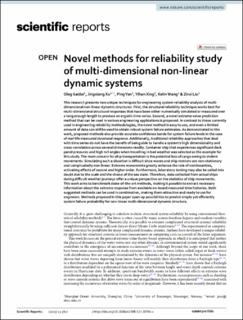| dc.contributor.author | Gaidai, Oleg | |
| dc.contributor.author | Xu, Jingxiang | |
| dc.contributor.author | Yan, Ping | |
| dc.contributor.author | Xing, Yihan | |
| dc.contributor.author | Wang, Kelin | |
| dc.contributor.author | Liu, Zirui | |
| dc.date.accessioned | 2023-12-04T11:55:33Z | |
| dc.date.available | 2023-12-04T11:55:33Z | |
| dc.date.created | 2023-03-09T21:32:05Z | |
| dc.date.issued | 2023 | |
| dc.identifier.citation | Gaidai, O., Xu, J., Yan, P., Xing, Y., Wang, K., & Liu, Z. (2023). Novel methods for reliability study of multi-dimensional non-linear dynamic systems. Scientific Reports, 13(1), 3817. | en_US |
| dc.identifier.issn | 2045-2322 | |
| dc.identifier.uri | https://hdl.handle.net/11250/3105804 | |
| dc.description.abstract | This research presents two unique techniques for engineering system reliability analysis of multi-dimensional non-linear dynamic structures. First, the structural reliability technique works best for multi-dimensional structural responses that have been either numerically simulated or measured over a long enough length to produce an ergodic time series. Second, a novel extreme value prediction method that can be used in various engineering applications is proposed. In contrast to those currently used in engineering reliability methodologies, the novel method is easy to use, and even a limited amount of data can still be used to obtain robust system failure estimates. As demonstrated in this work, proposed methods also provide accurate confidence bands for system failure levels in the case of real-life measured structural response. Additionally, traditional reliability approaches that deal with time series do not have the benefit of being able to handle a system's high dimensionality and cross-correlation across several dimensions readily. Container ship that experiences significant deck panel pressures and high roll angles when travelling in bad weather was selected as the example for this study. The main concern for ship transportation is the potential loss of cargo owing to violent movements. Simulating such a situation is difficult since waves and ship motions are non-stationary and complicatedly non-linear. Extreme movements greatly enhance the role of nonlinearities, activating effects of second and higher order. Furthermore, laboratory testing may also be called into doubt due to the scale and the choice of the sea state. Therefore, data collected from actual ships during difficult weather journeys offer a unique perspective on the statistics of ship movements. This work aims to benchmark state-of-the-art methods, making it possible to extract necessary information about the extreme response from available on-board measured time histories. Both suggested methods can be used in combination, making them attractive and ready to use for engineers. Methods proposed in this paper open up possibilities to predict simply yet efficiently system failure probability for non-linear multi-dimensional dynamic structure. | en_US |
| dc.language.iso | eng | en_US |
| dc.publisher | Springer Nature | en_US |
| dc.rights | Navngivelse 4.0 Internasjonal | * |
| dc.rights.uri | http://creativecommons.org/licenses/by/4.0/deed.no | * |
| dc.title | Novel methods for reliability study of multi-dimensional non-linear dynamic systems | en_US |
| dc.type | Peer reviewed | en_US |
| dc.type | Journal article | en_US |
| dc.description.version | publishedVersion | en_US |
| dc.rights.holder | © The Author(s) 2023 | en_US |
| dc.subject.nsi | VDP::Matematikk og Naturvitenskap: 400 | en_US |
| dc.subject.nsi | VDP::Medisinske Fag: 700 | en_US |
| dc.source.volume | 13 | en_US |
| dc.source.journal | Scientific Reports | en_US |
| dc.source.issue | 1 | en_US |
| dc.identifier.doi | 10.1038/s41598-023-30704-x | |
| dc.identifier.cristin | 2132886 | |
| cristin.ispublished | true | |
| cristin.fulltext | original | |
| cristin.qualitycode | 1 | |

